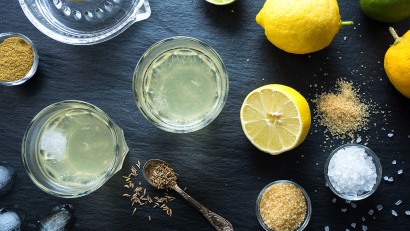- 1. Key Takeaways
- 2. Before You Go Backpacking
- 2.1. How Much Food Should I Bring?
- 2.2. What Type of Food Should I Pack?
- 2.3. What Essential Cooking Items Do I Need?
- 2.4. How Should I Wash My Dishes While Backpacking?
- 3. Backpacking Breakfast Ideas
- 3.1. Scrambled Powdered Eggs
- 3.2. Instant Oatmeal
- 3.3. Pre-made Overnight Oats
- 3.4. Pancakes
- 3.5. Granola or Cereal with Powdered Milk
- 4. Backpacking Lunch Ideas
- 4.1. Pre-made Sandwiches, Wraps, or Bagels
- 4.2. Pre-made Salad
- 4.3. Beef Jerky
- 4.4. Cheese and Crackers
- 4.5. Hummus Dip
- 4.6. Nuts and Dried Fruit
- 5. Backpacking Dinner Ideas
- 5.1. Ramen Noodles
- 5.2. Instant Soup
- 5.3. Pesto Pasta
- 5.4. Mac and Cheese
- 5.5. Veggie Couscous
- 6. Backpacking Snacks and Drinks
- 7. KÜHL’s Tips on Backpacking Meal Prep And Food Packing
- 8. Final Thoughts
- 9. FAQs
- 9.1. How to eat cheap when backpacking?
- 9.2. Are backpacking meals healthy?
- 9.3. How often should you eat while backpacking?
- 9.4. What foods should you avoid when backpacking?
- 9.5. How long do backpacking meals last?
- 9.6. What to do with food at night when backpacking?
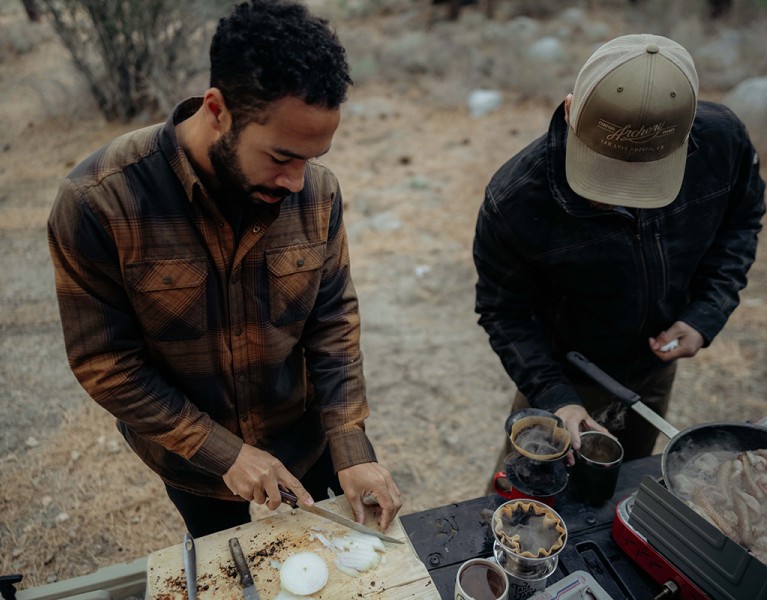
Best Backpacking Meals: KÜHL's Top Backpacking Food Ideas
Table of Contents [Show]
Backpacking is exhausting and energy-intensive. That’s why hiking food requires special consideration in any backpacking checklist.
Just because the food needs to fit in your backpack does not mean settling for boring and repetitive meals. Backpacking food can be nutritious, flavorful, and lightweight- you only need a little planning and a backpacking meal plan like this one.
For today’s guide, we’re sharing cheap and easy backpacking meals for breakfast, lunch, and dinner. We’ve also included our favorite backpacking snacks and drinks to help boost your energy and curb hiker hunger.
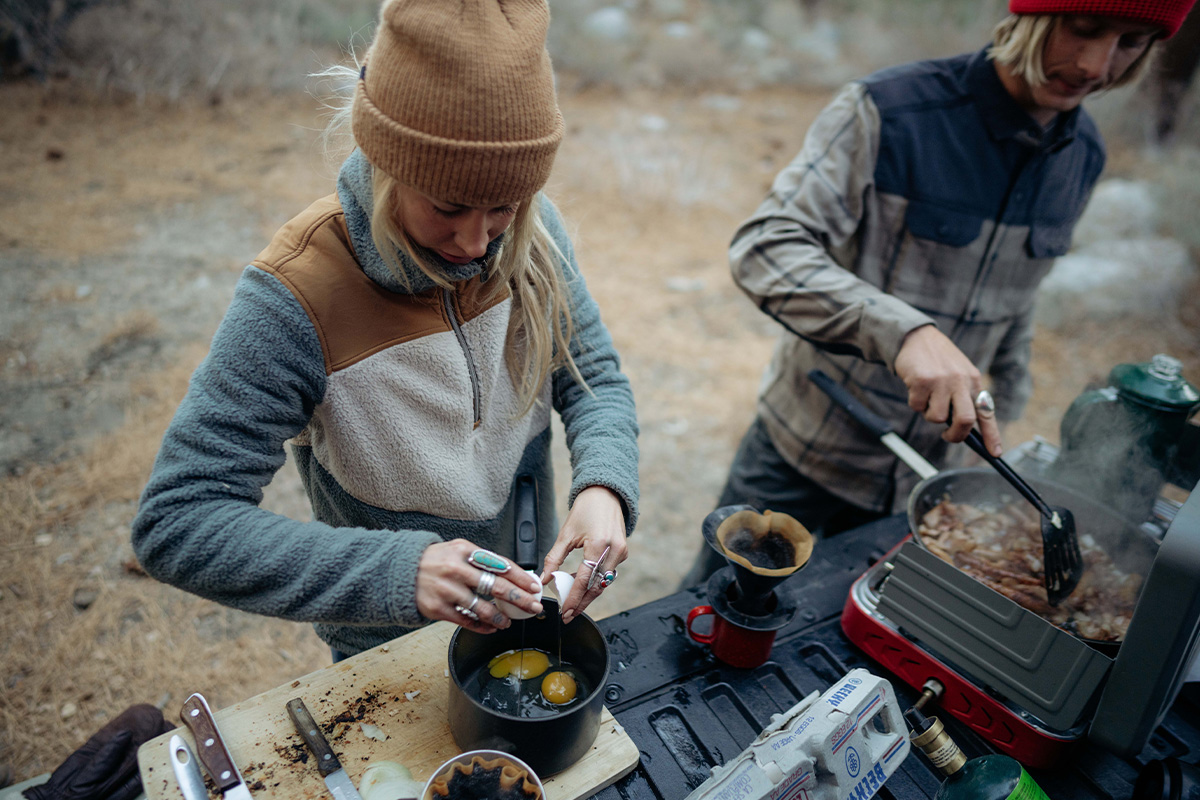
Key Takeaways
- Quality backpacker meals are necessary to maintain energy levels and replenish calories.
- Experimenting with different backpacking food ideas is essential to acquiring the skills necessary for ultralight backpacking and hiking meal planning.
- The average backpacker requires 1.5 lbs to 2 lbs or 2500-4500 calories of daily food.
- Balancing proper nutrition and the weight of your backpacking lunches, dinners, breakfasts, and snacks takes skills.
Before You Go Backpacking
How Much Food Should I Bring?
Short answer
Plan for between 1.5 lbs and 2.5 lbs worth of food (or about 2500 to 4500 calories) per person per day.
Long answer
The amount of food to bring during a backpacking trip will depend on many factors. These include:
- Your weight
- Personal preferences
- Fitness level
- Basal Metabolic Rate (BMR)
- Backpack weight
- Hiking speed
- Targeted hiking distance per day
- Terrain difficulty
- The area’s climate
That said, there are two ways of figuring out how much hiking food you should carry: pounds of food per day and calories per pound of your body weight.
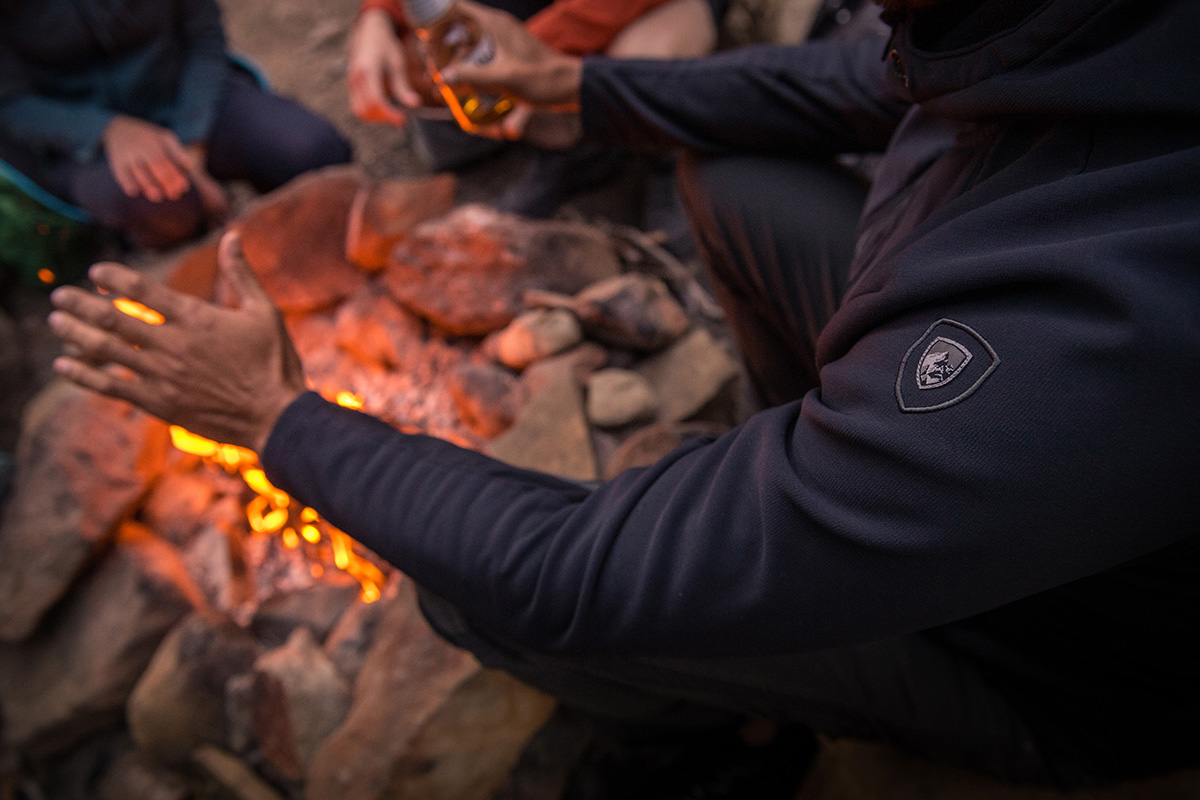
Pounds of Food Per Day
The recommendation is to pack 1.5 to 2.5 lbs worth of food per hiker per day. This method is for 12-mile hiking trips and under.
You throw a bunch of meals while weighing the food bag to ensure that you have around two pounds of food per day.
While it’s easier than tallying calories, this method does not consider the number of calories in every food item. Depending on the type of food you bring, you could be having fewer calories one day and more calories than necessary the next day.
The worst-case scenario is the food won’t provide enough calories to match your hiking distance and pace. This may leave you feeling sluggish. It may also hamper recovery, which affects how you wake up the following day.
Calories per Pound of Body Weight
Using this method, the average hiker should pack 25 to 30 calories worth of food per pound of body weight. This estimate is for strenuous hiking days with a backpack. For moderate hiking (60-120 minutes per day), 21-25 calories per pound of body weight is a good estimate.
Going by this method, a 180-pound hiker getting ready for long days of hiking with a backpack should carry 4500-5400 calories worth of food per day.
Counting calories when packing for a hiking adventure is painstaking. But it’s typically regarded as a more reliable method of calculating how much food to bring when backpacking.
Even so, this is just an estimate and may not match every hiker’s caloric needs in different hiking scenarios. But you’ll soon figure out what works best for you as you experiment and fine-tune your backpacking recipes.
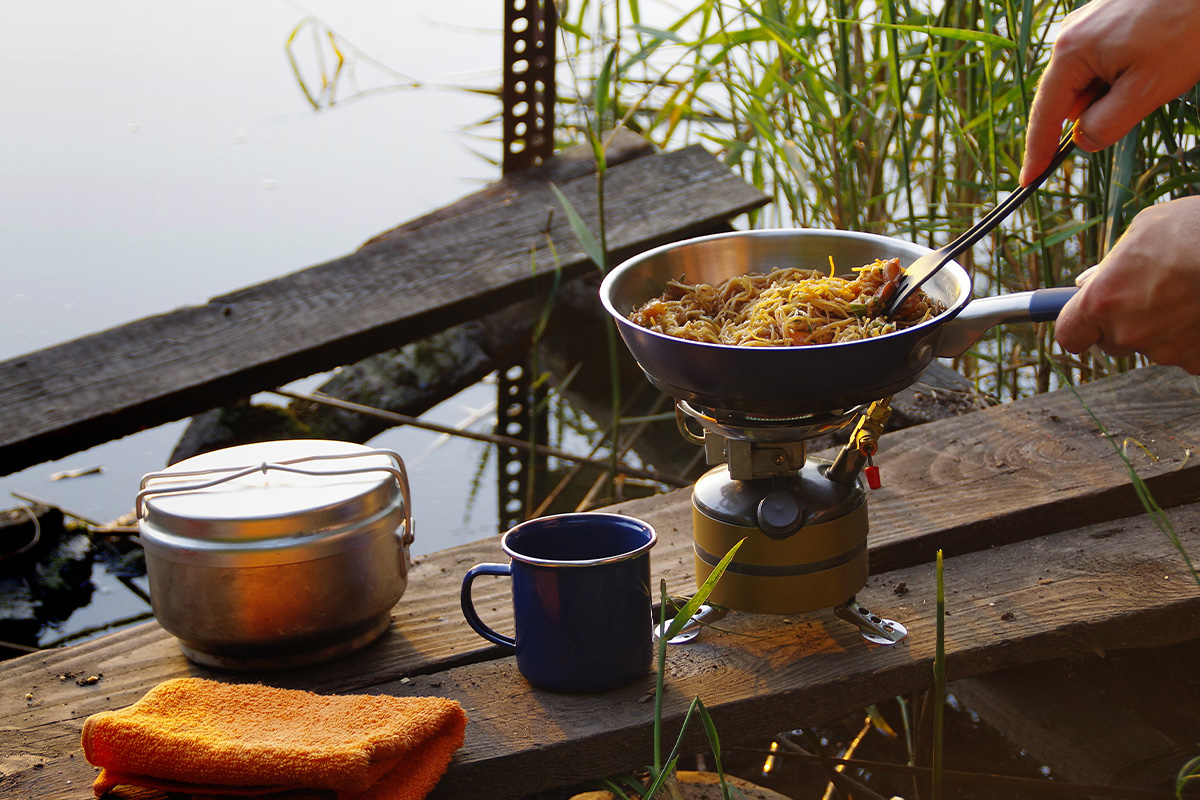
What Type of Food Should I Pack?
When selecting what foods to bring on a hike, it’s crucial to aim for food that is energizing, easy to prepare, non-perishable, and lightweight.
The best backpacking foods are those that provide the energy to hit the trail without weighing you down. Ensure you bring a variety of the foods you like.
Grocery-bought dehydrated and freeze-dried foods tend to be the best in terms of weight and convenience. Plus, they don’t require a lot of cleanup compared to cooking your food from scratch. Just ensure that they are calorie-dense. Select foods that provide at least 125 calories per ounce.
The good news is that you can also dehydrate your backcountry meals at home before the camping trip. Although it takes time, dehydration allows you to bring your favorite meals into the woods. An additional bonus here is being in control of what goes into your food.
In addition to water, bring other beverages to help you stay hydrated, alert, and energetic. Some excellent options include hot chocolate, chai, matcha, green tea, ginger-turmeric tea, and chicken or beef broth.
Where to Buy
As a casual backpacker, freeze-dried and just-added-water meals add a lot of value and convenience to your hiking adventures. As more people embrace outdoor living, prepackaged food companies have diversified their offerings.
Now, it’s possible to get pretty much whatever trail food you want. It doesn’t matter whether you’re a meat-eater, vegetarian, or on a diet. There are backpacking breakfasts, lunches, and dinners of all flavors to suit your palate.
Some of the best backpacking meals brands include:
- Mountain House
- Peak Refuel
- AlpineAire Foods
- Pinnacle foods
- Good to Go
- Fernweh Food Company
- Backpacker’s Pantry
- Pack It Gourmet
- Switchback Foods
- RightOn Trek
- Gastro Gnome
- Patagonia Provisions
- Farm to Summit
- Nomad Nutrition
What Essential Cooking Items Do I Need?
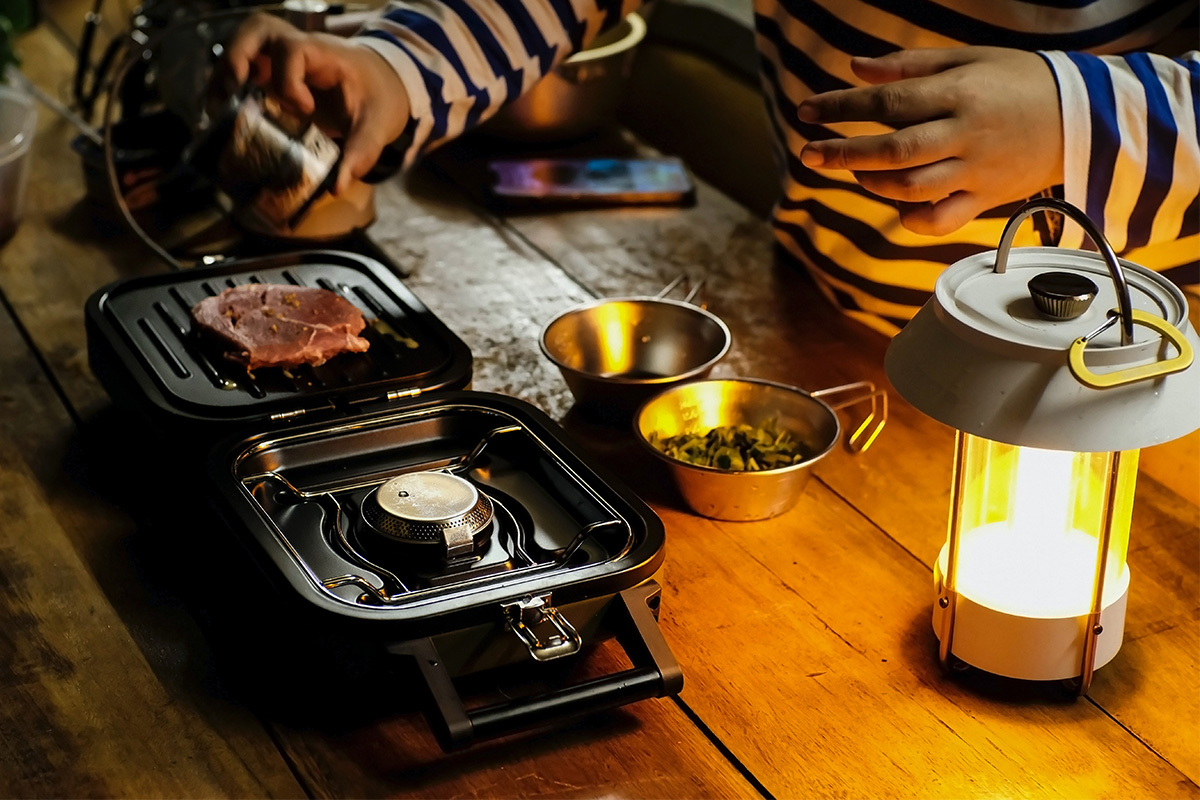
Stove
The best stove for backpacking needs to be lightweight and dependable. An all-in-one stove system like the Jetboil Flash is an excellent pick, especially for new backpackers who value convenience. With the ability to boil a liter of water in around three minutes, this is a great companion for preparing dehydrated meals, coffee, soups, and broths on the trail.
Backpacking pots and lids
Look for hard-anodized aluminum pots, as they are lightweight, durable, and scratch-resistant. One large pot enough to hold a pint of water per backpacker is fine for rehydrating hydrated backpacking meals. For melting snow and cooking for two backpackers, a 1200-1800 ml pot will be a good balance between size and volume.
Frying pan
A frying pan will be a lovely addition if you’re the type of backpacker who prefers a nicely fried breakfast or dinner. The 8” Sea to Summit Alpha pan with a collapsible silicone grip handle and non-stick coating is great for a solo camper.
Windshield
Camping stove windshield makes cooking outdoors easy by protecting the stove’s flame from the wind. It maximizes your cooking efficiency by saving fuel, besides making it possible to adjust your cooking temperature.
Spice kit
The extra weight of spices and condiments (oregano, mayo, pepper, salt, and garlic powder) is totally worth it when backpacking. A spice kit makes it easy to bring all the essential ingredients and keep everything organized.
Food storage
Proper camping food storage ensures that the broth you prepared with your nana’s secret recipe doesn’t go to waste. It also prevents bears, raccoons, and other unwanted guests from snacking on your food. Consider airtight containers for highly aromatic meals.
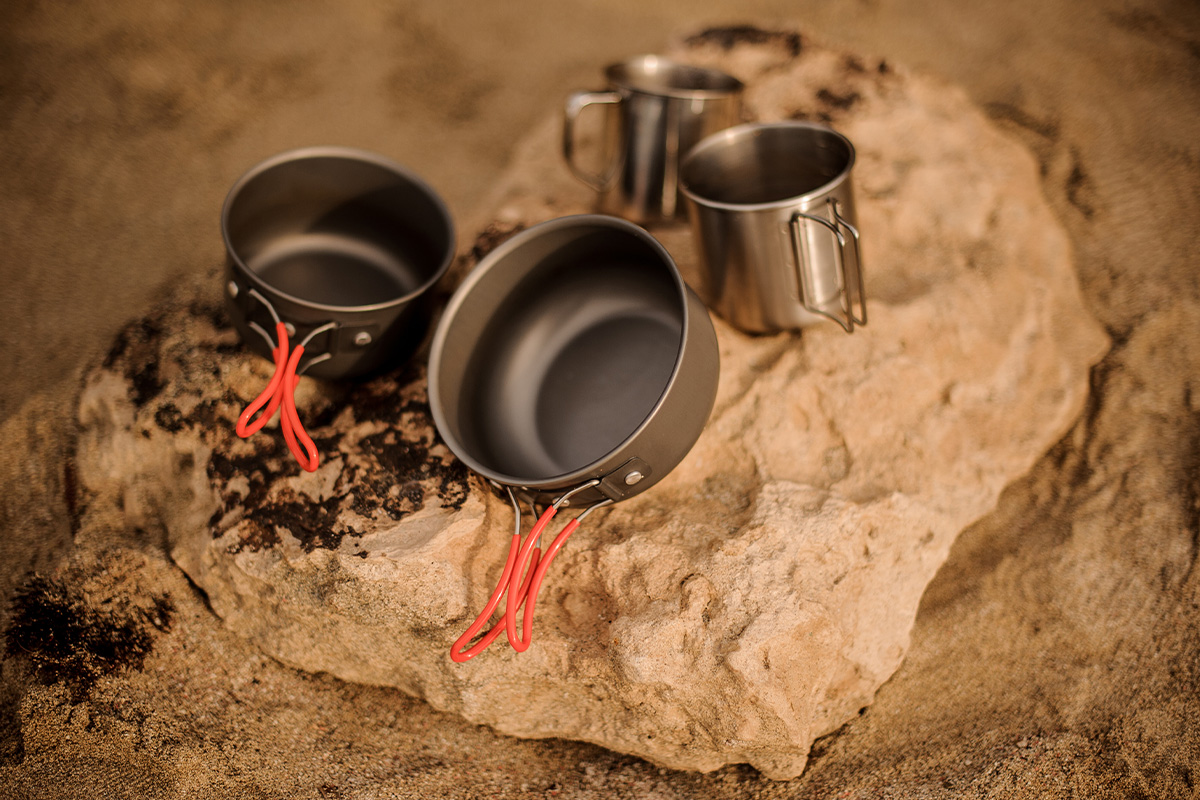
How Should I Wash My Dishes While Backpacking?
What You’ll Need
- Two collapsible sinks or any bucket or plastic tub that can fit your dishes and hold enough water.
- Sponge
- Pan scraper
- Biodegradable soap
- Fine mesh strainer
Step-by-Step Process of Washing Dishes When Backpacking
- Set up your wash and rinse sinks. Add warm water and a few drops of biodegradable soap in the wash basin and cold water in the rinse basin.
- Scrap all the food residue in your plates, pans, and pots into the trash using the pan scraper.
- Now, immerse your silverware in the soapy water to rinse. Next, start washing your dishes one at a time. Start with the least dirtiest, followed by the most soiled pots with stuck-on food.
- After washing, dunk the dishes in the second basin for rinsing.
- After the rinse phase, set the dishes out to dry or use a clean cloth to hand dry them.
- Next, consolidate your gray water by dumping the rinse water into the wash sink.
- Use a strainer or sieve to strain out food scraps. Empty the filter into your trash.
- Dispose of your gray water by tossing it at least 200 feet from the trail and any water source.
Backpacking Breakfast Ideas
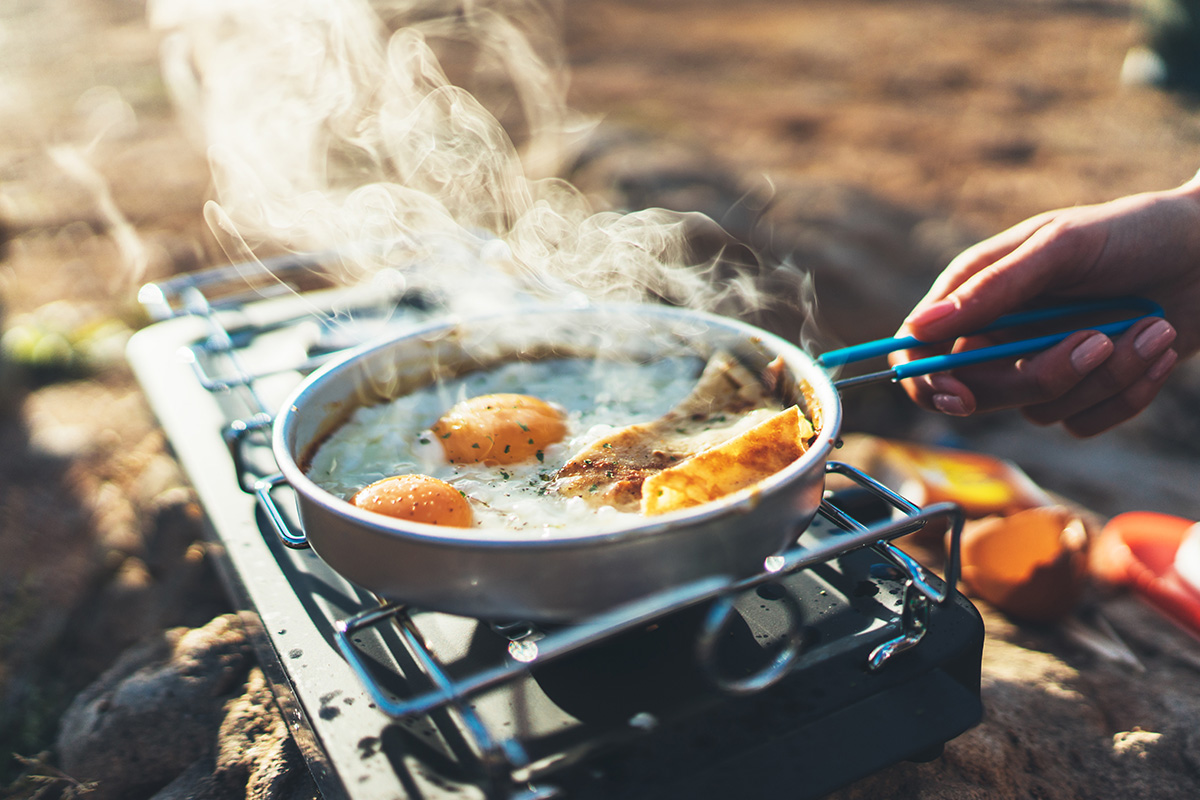
Scrambled Powdered Eggs
With their high calorie-to-weight ratio, scrambled powdered eggs are an excellent option for an energizing pre-hike breakfast. Scrambled powdered eggs are convenient to carry and add a nice protein punch to all your backpacking meal ideas.
Ingredients
- A pack of scrambled powdered eggs (we love Ovaeasy Egg Crystals)
- Water
How to prepare
- For two eggs, mix four tablespoons of powdered eggs and six tablespoons of water.
- Stir to achieve a smooth consistency, then cook as you normally would.
Instant Oatmeal
Oatmeal is a good backpacking meal because it’s satisfying, straightforward, and a breeze to clean up after.
Ingredients
- Instant oats (like these organic sprouted rolled oats from One Degree)
- Milk powder or milk
- Maple syrup, coconut sugar, or honey
- Nuts and seeds like almonds and walnuts for that added crunch
How to prepare
- Put ½ cup of instant oats into a bowl and pour ¾ of boiling water or milk.
- Stir and let it sit for 2-3 minutes.
- Add a dash of your favorite sweetener, for instance, maple syrup or honey, and a few spoons of nuts and seeds to make it wholesome.
- Enjoy
Pre-made Overnight Oats
This recipe is yours if you are a fan of completely no-cook backpacking breakfast ideas. It’s best when you need an energy-boosting breakfast but time is not on your side. This meal is made the previous night for breakfast the following morning.
Ingredients
- ½ cup old-fashioned oats
- ½ cup water or milk
- A pinch of salt
- 2 tablespoons nuts or seeds
How to prepare
- Combine the oats and water/milk in a ziplock bag, jar, or other sealable container. Let the mix stay overnight.
- In the morning, add a pinch of salt and your choice of seeds and nuts.
- Enjoy
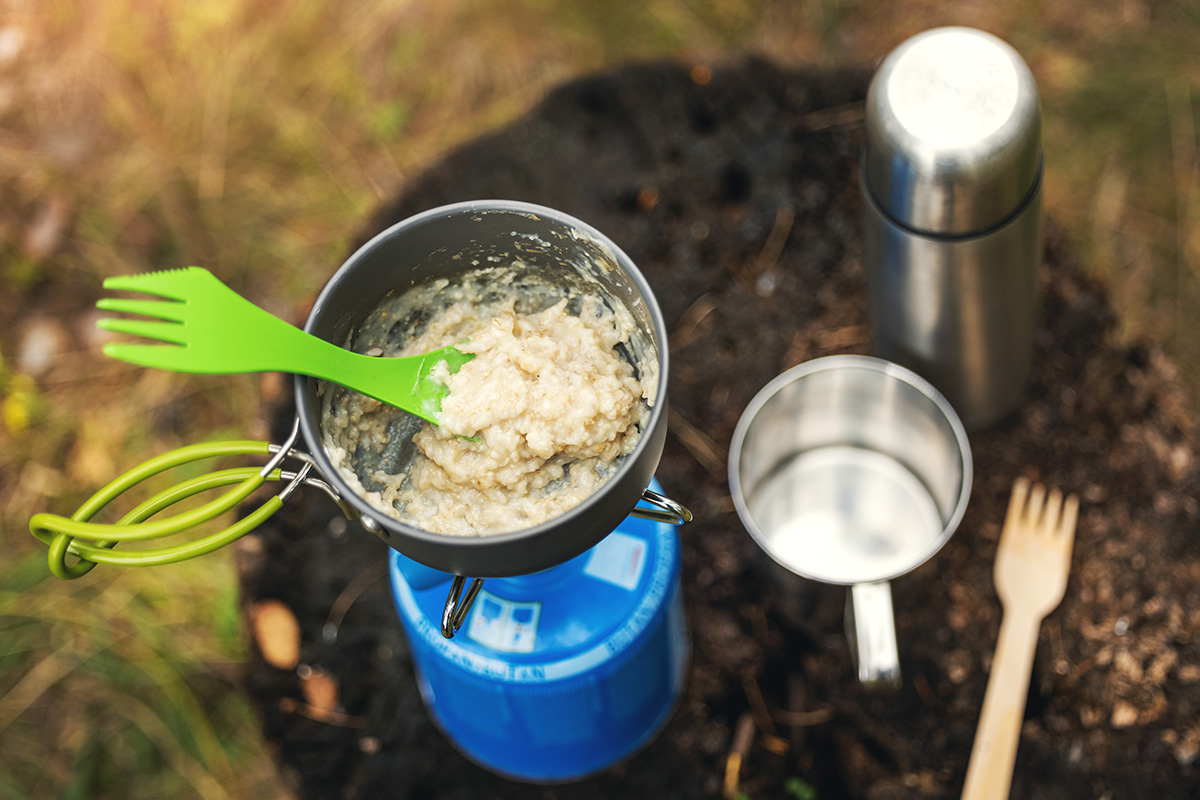
Pancakes
Full of carbs, trail pancakes are just what you need when you have a day of intense hiking ahead.
Ingredients
- Pre-made pancake mix like Coyote. You can also bring your homemade mix.
- Scrambled powdered eggs (optional)
- Cinnamon and walnuts
How to prepare
- Combine your pre-made pancake mix and scrambled powdered eggs in a bowl or backpacking pot.
- Add enough water to the mix to achieve your desired thickness, then stir.
- Allow the batter to sit for 10-15 minutes before cooking if you prefer fluffier pancakes.
- After cooking, add any toppings of your liking, such as peanut butter, syrup, or even fruits.
Granola or Cereal with Powdered Milk
This is one of the best DIY backpacking meals for a quick breakfast on the trail.
Ingredients
- 100g granola
- 30g powdered milk
- 6oz water
How to prepare
- Combine everything in a bowl
- Stir until all the powdered milk has dissolved perfectly
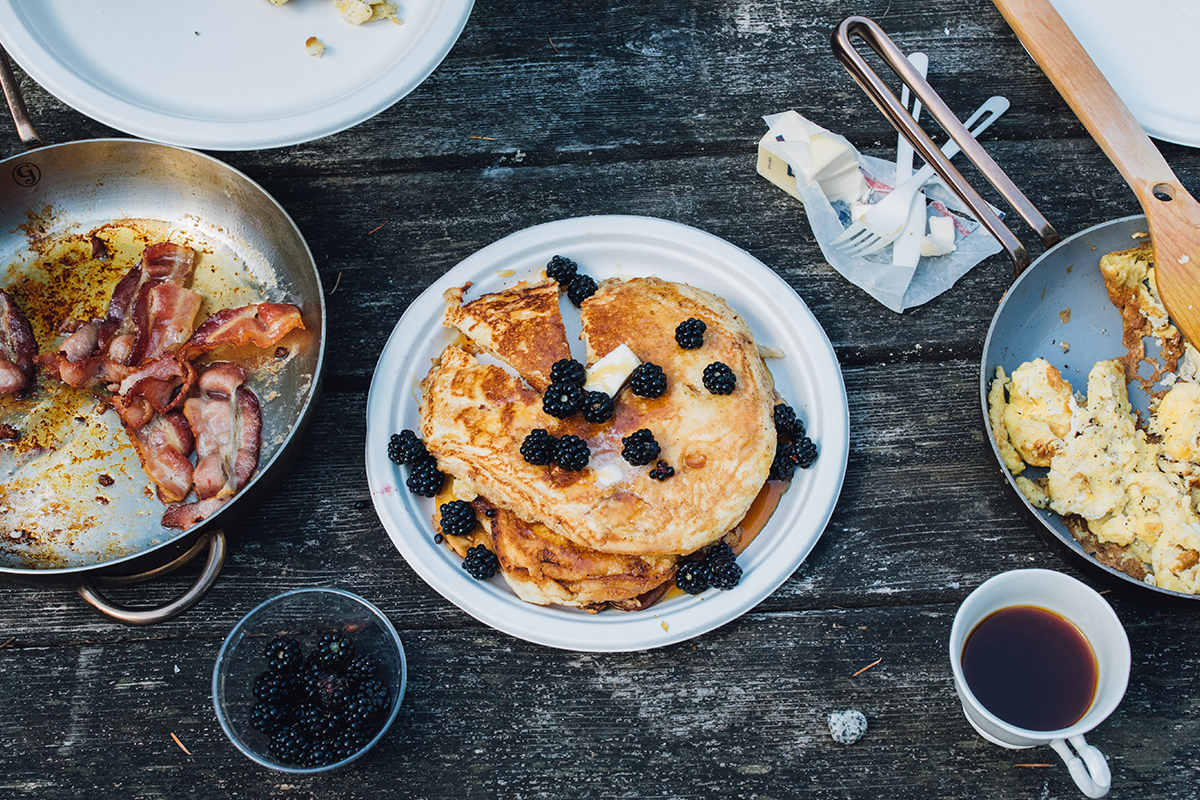
Backpacking Lunch Ideas
Pre-made Sandwiches, Wraps, or Bagels
Pre-made sandwiches, wraps, or bagels are perfect backpacking lunch ideas. In addition to being lightweight, they are super versatile. Feel free to stuff them with whatever toppings that take your fancy. However, it’s advisable to hold the mayonnaise as it tastes odd when left in a warm bag for hours.
Pre-made Salad
Pre-made salads can be good backpacking meals for lunches if you are a fan of shortcuts. You can go with anything from a meat-based salad like this Bumble Bee Chicken Salad or just a pasta salad loaded with all the vegetables you desire on the trail.
The Bumble Bee Chicken Salad comes with six crackers, a can of chicken salad, and a spoon. When you’re ready for lunch, spread the salad on the crackers, and you’re done.
Beef Jerky
Jerky is a go-to backpacking meal ideal for most hikers because it provides a boost of energy when you need it most. While it’s often eaten as a snack, beef jerky can be a whole meal, too, for instance, when combined with instant noodles.
Ingredients
- Jeff’s Sweet Teriyaki Beef jerky
- Instant noodles
How to prepare
- Cut the beef into bite-sized pieces and combine with the noodles in a bowl
- Boil water in a camping pot
- Add the beef jerky and noodles mix to the water and stir
- Serve and enjoy
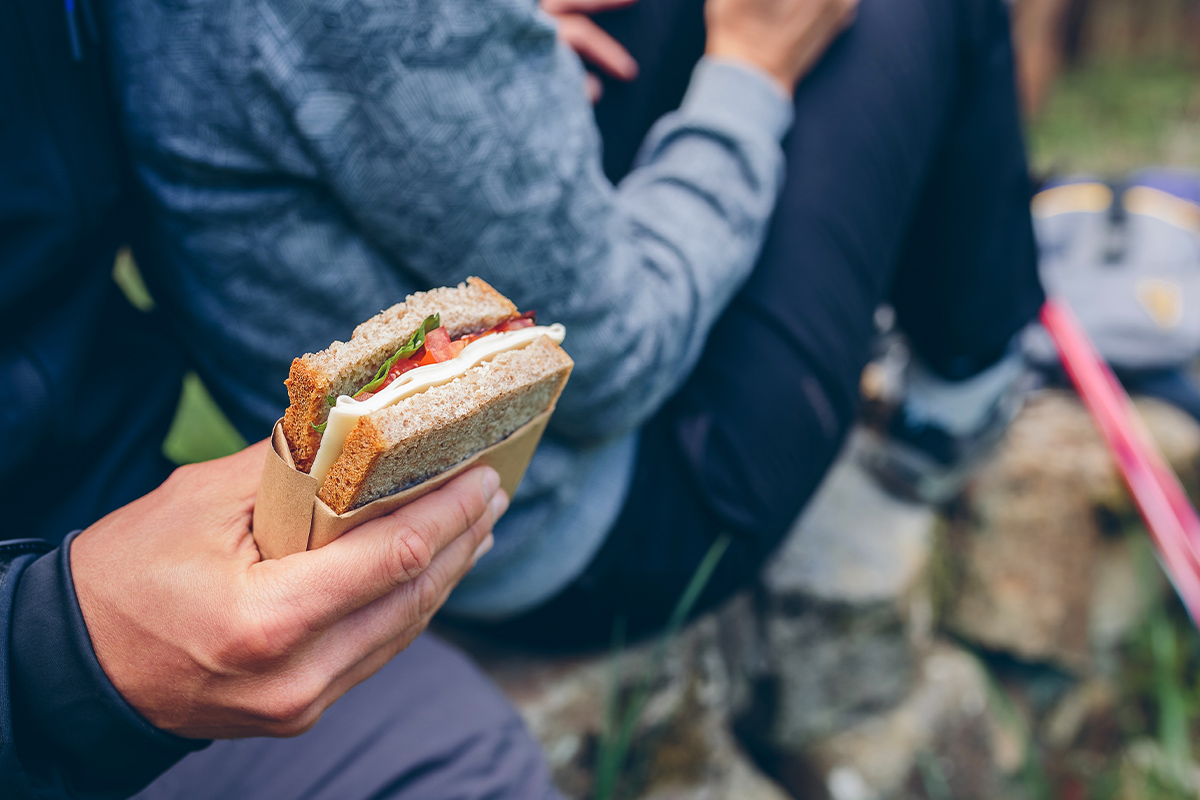
Cheese and Crackers
Cheese and crackers are a popular option in most picnic food ideas. It also makes for a simple and quick lunch or dinner on the trail.
Ingredients
- Crackers (any of your choice)
- Cheese- choose high-quality, harder cheeses. Cheddar and Parmesan cheese are our favorites.
- Fruits, nuts, and fresh herbs (optional)
How to prepare
- Lay your favorite crackers on a plate
- Place a slice of cheese on each cracker
- Top with a drizzle of honey or your choice of fruits or nuts
Hummus Dip
Another staple for serious thru-hikers, hummus is super lightweight, non-perishable, and high in natural protein- just what your muscles need on the trail. Hummus is super versatile, too, and will add a bit of flare to so many meals.
Ingredients
- 1 cup powdered hummus
- 1.5 cups water
- 1 tablespoon olive oil
- Toppings- spice blends, pine nuts, and sun-dried tomatoes
- Dippers- sturdy crackers, pretzel sticks, or vegetable chips
How to prepare
- Add 1.5 cups of water and a tablespoonful of olive oil to the powdered hummus.
- Stir to blend.
- Enjoy by the spoonful or with your preferred dippers.
Nuts and Dried Fruit
Nuts and dried fruit mix make for a calorie-dense meal. Good quality trail mix, either homemade or bought from the grocery store, will keep you satiated on the trail and provide a quick energy boost. And because it’s hydrated, the mix is lightweight and easy to carry.
To create a nutritious trail mix;
- Include a variety of nuts, such as almonds, walnuts, and cashews.
- Add dried fruits, such as goji berries, apricots, and raisins, to add a burst of flavor and sweetness.
- You can also include seeds, such as chia seeds, flax seeds, or sunflower seeds.
- Divide the trail mix into single-serve portions for added convenience on the trail.
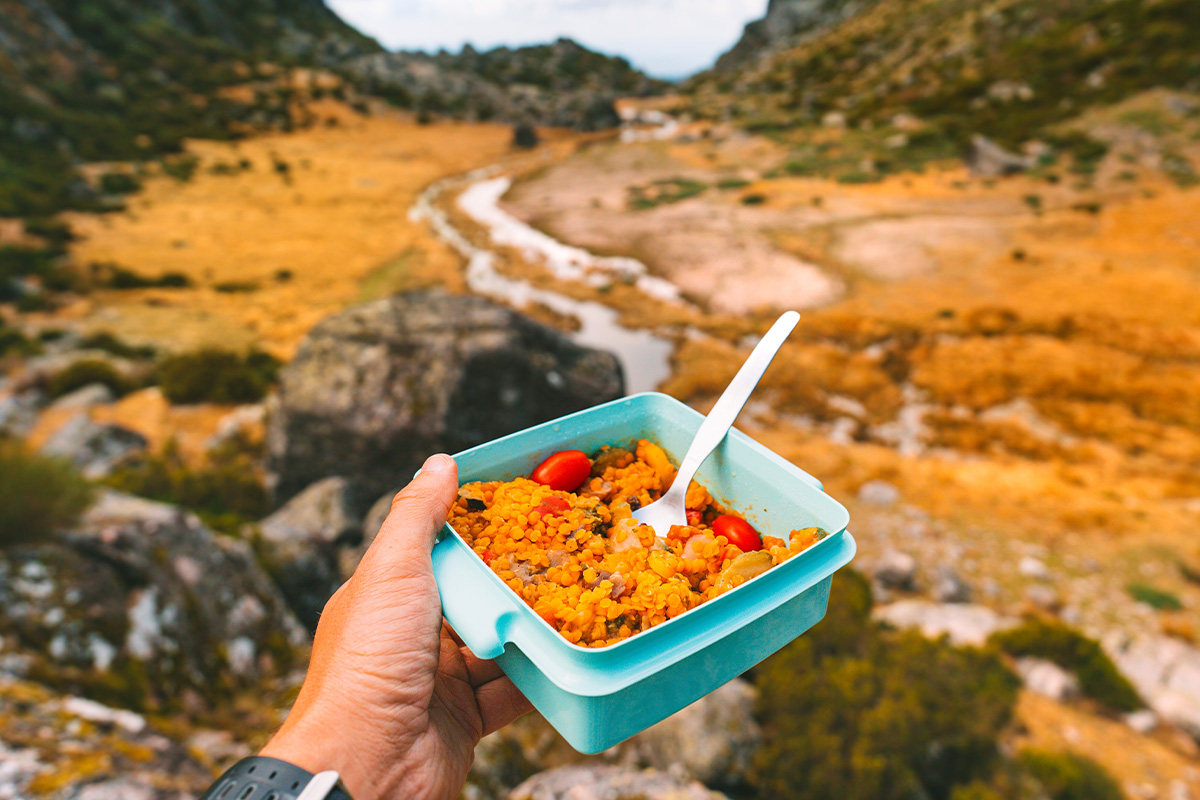
Backpacking Dinner Ideas
Ramen Noodles
Ramen noodles are lightweight, cheap, convenient, and easy to prepare at home and on backpacking trails. No wonder they are a fan favorite among most thru-backpackers.
Ingredients
- 1 packet ramen noodles (85g)
- ¼ tablespoon garlic powder
- ¼ tablespoon black pepper
- 1 tablespoon dried parsley
- Salt (to taste)
- ¼ cup shelf-stable parmesan cheese
- 3 tablespoons olive oil
- 8oz water
How to prepare
- Add the noodles to boiling water and let rehydrate for around five minutes.
- Add all other ingredients and stir to mix well. Let the meal stand for approximately three minutes before serving.
Instant Soup
Instant soup is another must-have on your list of backpacking dinners. This just-add-water meal is a sure-fire way to warm cold bodies on cold nights. You can buy instant soup packets online or from your local grocery store.
Instant soups are also one of the best homemade backpacking meals if you have a dehydrator:
At home
- cook a thick soup with ingredients of your choice
- Blend the whole batch or whip it smooth
- Spread the soup on dehydrator trays and dehydrate
- Grind the brittle soup bark into soup powder and package in ziplock bags
On the trail
- Pour the dehydrated soup powder into a pot of boiling water
- Mix well and enjoy
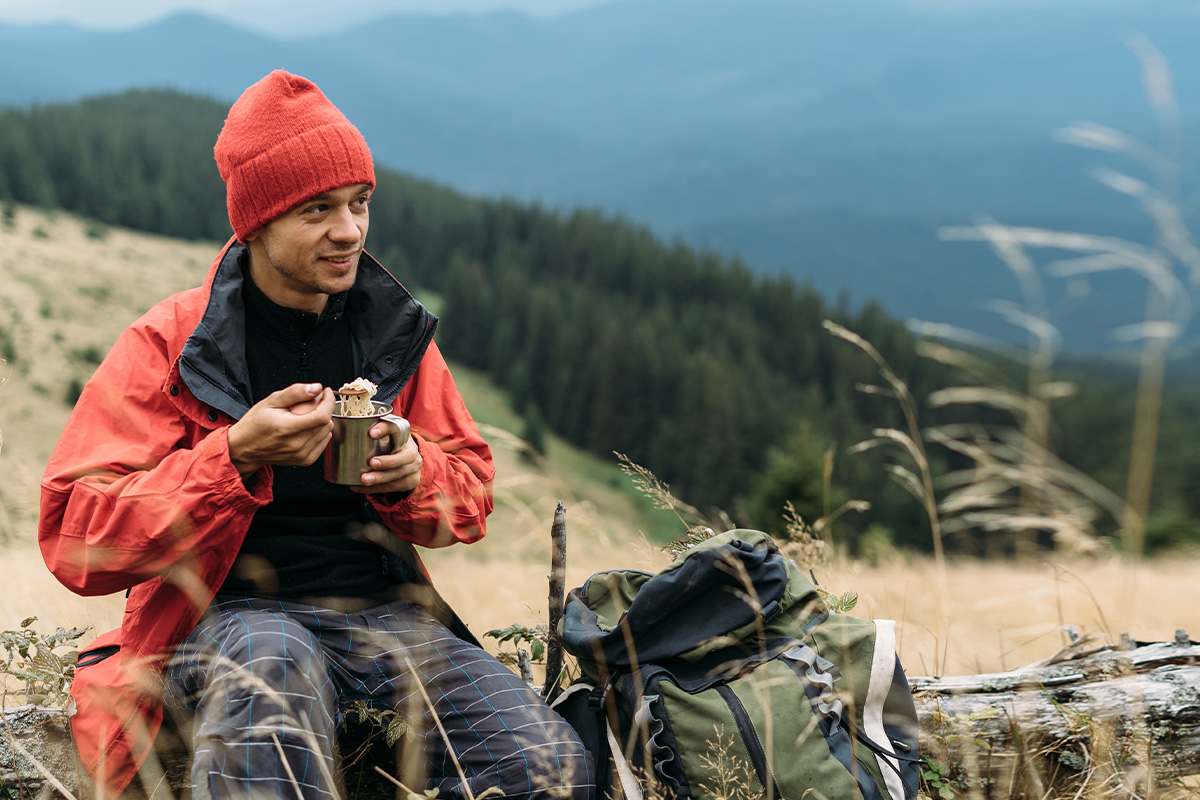
Pesto Pasta
Good ol’ trusty Pesto Pasta is another hearty and yummy meal you shouldn’t lack in your backpacking cooking ideas.
Ingredients
- 250g pasta
- 100 ml basil pesto sauce
- 3 tablespoons olive oil
- Chopped chili (fresh or dried; optional)
- 100g snow peas (optional)
- ½ tablespoon salt
How to prepare
- Bring the water to a boil
- Add pasta and salt
- Let the pasta cook until tender
- Add chili and snow peas (if using) two minutes before the pasta is cooked
- Drain all the water
- Add olive oil and stir to mix well
Mac and Cheese
This is another satisfying meal you can whip up easily using a few grocery store items.
Ingredients
- 1 box macaroni and cheese dinner
- ½ cup mixed vegetables (dehydrated)
- 3oz can chicken
How to prepare
- Rehydrate the mixed vegetables with ½ cup of water for about 15 minutes
- Add 2.5 cups to your camping pot. Add the rehydrated vegetables and bring to a boil
- Add in the macaroni and cheese mix and let simmer for approximately seven minutes
- Turn off the stove and let sit for another five minutes, covered tightly
- Add the chicken sauce and stir well to mix
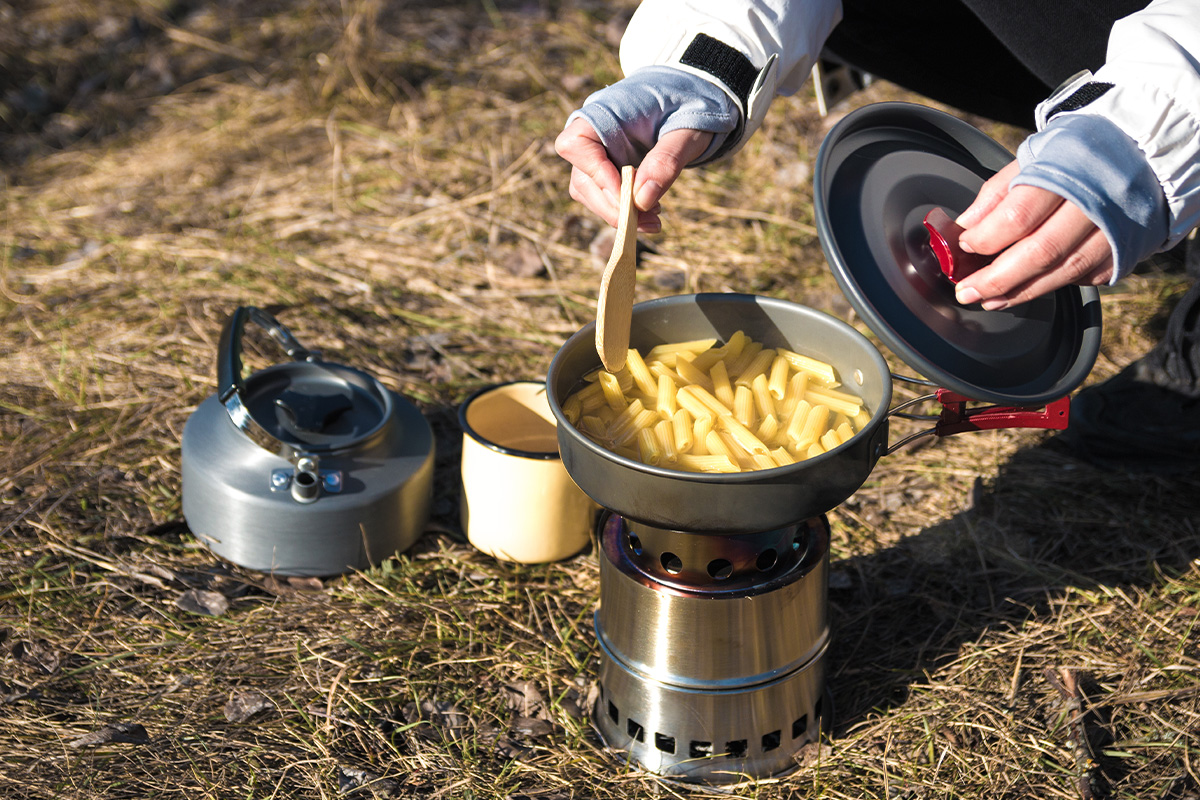
Veggie Couscous
Vegetable couscous is an excellent backpacking meal recipe, especially when feeding a large group. It’s easy to prepare, nutritious, and packed with flavor.
Ingredients
- 200g couscous
- 2 packets of parmesan cheese
- ½ dehydrated zucchini
- 1 dehydrated carrot
- 1 cup dehydrated spinach
- ¼ tablespoon garlic powder
- ⅛ tablespoon salt
- ¼ tablespoon powdered red chili
How to prepare
- Bring water to a boil and add the couscous, vegetables (except chili), and seasoning to taste
- Let simmer for about five minutes while stirring frequently
- When the couscous and vegetables are cooked, add red chili and two packets of parmesan cheese.
- Serve
Backpacking Snacks and Drinks
- Water - the general recommendation is to carry at least one liter of water for every hour of hiking.
- Fresh Fruits & Veggies - you can also include some fresh fruits and vegetables for the first 24-48 hours. If possible, bring some oranges, apples, carrots, bell peppers, onions, and broccoli. They will weigh a bit more, of course. But you’re adding quality food to your gas tank. Plus, the weight reduces fast after the first day or two.
- Energy Bars - a mainstay for backpackers, energy bars are the perfect way to boost your energy level on the fly.
- Candy - this can be your friend when backpacking because the sugar provides a quick boost. However, these should only be used to enhance lower-calorie meals, not as a substitute.
- Coffee - instant coffee is a reasonable compromise for backpackers who rely on caffeine to power up in the morning and fight off the midday slump.
- Tea - a hot cup of tea is an excellent way to hydrate and relax after a day of hiking. Like instant coffee, tea is lightweight and takes minimal room in your backpack.
- Alcohol - although not a backpacking essential, a little whiskey around the campfire can be a great end-of-the-day celebration.
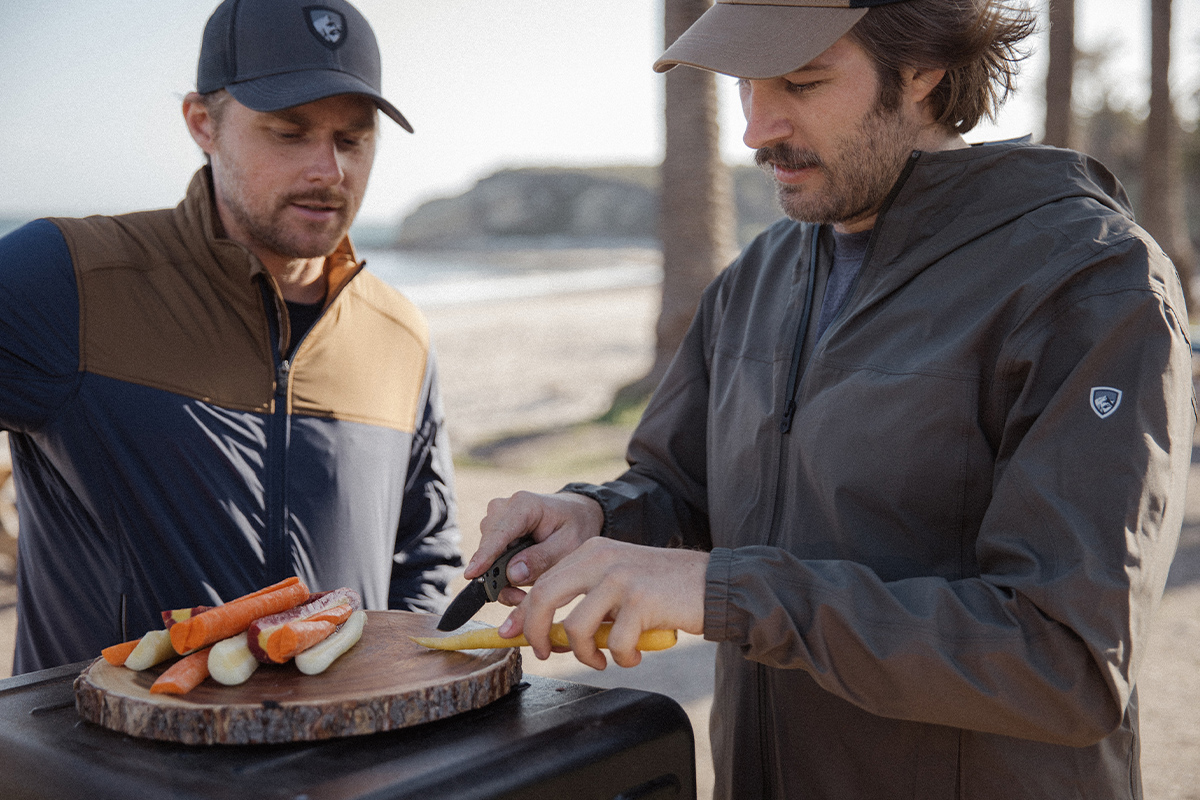
KÜHL’s Tips on Backpacking Meal Prep And Food Packing
Here are essential tips and strategies to have in mind when backpacking meal planning:
- Although pricey, dehydrated and freeze-dried backpacking meals are convenient and lightweight and taste great with proper preparation.
- Choose convenient backpacking food (those that require minimal preparation) so you can focus more on the trail.
- When shopping for the best food for backpacking, always check the nutrition information panel to ensure the food contains enough calories. A good backpacking meal should contain at least 125 calories per ounce.
- Removing excess packaging on backpacking food at home helps reduce the weight of your consumables.
- While thru-hikers are recommended to pack up to 4500 calories (or more) per day, you don’t need this much when overnight or weekend backpacking. Shoot for about 3000 calories instead. You won’t starve for burning more calories than you consume for a day or two anyway.
- Bring a variety of food. Nothing will kill your backpacking vibe more than repeating the same boring food on the trail.
- Substitute low-caloric food items with high-caloric food items like nuts, ghee, and olive oil. It makes balancing calories and lightweight packing much easier.
Final Thoughts
Life’s too short to make do with bland food on the trail. When you’re in the woods, you want nutritious meals that provide sustained energy to keep you going. However, your backpacking meal ideas also need to factor in the total weight of your pack.
Packing the best backpacking food while balancing weight and space requires skills and preparation. This is one aspect of backpacking that you only learn by actually doing it.
So, get out there, experiment with, and fine-tune different backpacking meal recipes to figure out what works for you. Only then will you acquire the nutritional and decision-making skills necessary to stay comfortable and full of energy in your backpacking adventures.
Superior mobility in Joyrydr™ and Burr™ Jacket to make your cooking easier.
FAQs
How to eat cheap when backpacking?
Here are key tips for eating healthy while backpacking on a budget:
- Buy your food at local grocery stores.
- Don’t skip breakfast. Doing this denies your body vital calories, and you often eat more at lunch.
- Dehydrate your food at home.
Keep it simple. Most seemingly run-of-the-mill foods like dehydrated mashed potatoes, oatmeal, and ramen are calorie-dense yet inexpensive.
Are backpacking meals healthy?
Prepackaged dehydrated backpacking meals need to balance calorie count, convenience, and ease of preparation. Hence, some marks are lost healthwise.
How often should you eat while backpacking?
The general recommendation is to eat small and often (ideally, every one to two hours).
What foods should you avoid when backpacking?
You’ll be wise to avoid foods that go bad easily, including cream-based soups, milk, and fruit juices.
How long do backpacking meals last?
Most freeze-dried and dehydrated backpacking meals last anywhere between 5 and 30 years. However, you should discard any pouch with damp food inside.
What to do with food at night when backpacking?
Leftover backpacking meals can be resealed and put in the trash.

